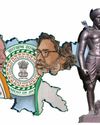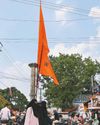Akalis are seen as useless amid economic distress; the Congress is patchily popular. It’s the AAP many in Punjab are turning to.

FROM the fog that descends on winter nights over Punjab’s yellow and green mustard fields emerges a glimpse of an unpredictably theatrical electoral verdict. Cruising through the state’s verdant malwa and Doaba regions, where lie about ninety of its 117 assembly constituencies, it seems the Aam Aadmi Party has parachuted deep into the electoral terrain here.
Two months ago, the usual pre-election debates dominated Punjab: The scourge of drug abuse, the related grouse over lack of employment and the decline of agriculture. From contributing almost 60 per cent to the state GDP in the ’70s, the share of agriculture declined to under a quarter in the last decade, while the agricultural growth rate twice plunged into the negative zone.
These factors were steadily eroding the Shiromani Akali Dal vote bank, and creating support for the Congress and AAP. But then, the Centre’s demonetisation, announced in early November, dramatically changed scenarios. Where discontent and anti-incumbency were already writ large, the war on black money added another deep wrinkle to the pre-electoral process.
In several villages in the Mansa, Moga, Sangrur and Bathinda districts, many people say that they will shift allegiance in the upcoming state polls to the ‘jhadoo wali party’ due to dissatisfaction with the ruling coalition. A good many say they are undecided, but are also considering AAP.
These districts are part of Punjab’s Malwa region, with people considered to be boldly outspoken. The reason they cite most for considering a party with no track record in Punjab is their anger against existing alternatives, which they perceive to have fostered a wide chasm between the rich and poor. The Congress is popular, especially in Patiala—Amarinder Singh’s hometown—but many more seem to hold the view that even that party has allowed the poor to turn poorer and the rich richer.
Diese Geschichte stammt aus der January 09, 2017-Ausgabe von Outlook.
Starten Sie Ihre 7-tägige kostenlose Testversion von Magzter GOLD, um auf Tausende kuratierte Premium-Storys sowie über 8.000 Zeitschriften und Zeitungen zuzugreifen.
Bereits Abonnent ? Anmelden
Diese Geschichte stammt aus der January 09, 2017-Ausgabe von Outlook.
Starten Sie Ihre 7-tägige kostenlose Testversion von Magzter GOLD, um auf Tausende kuratierte Premium-Storys sowie über 8.000 Zeitschriften und Zeitungen zuzugreifen.
Bereits Abonnent? Anmelden

IMT Ghaziabad hosted its Annual Convocation Ceremony for the Class of 2024
Shri Suresh Narayanan, Chairman Managing Director of Nestlé India Limited, congratulated and motivated graduates at IMT Ghaziabad's Convocation 2024

Identity and 'Infiltrators'
The Jharkhand Assembly election has emerged as a high-stakes political contest, with the battle for power intensifying between key players in the state.

Beyond Deadlines
Bibek Debroy could engage with even those who were not aligned with his politics or economics

Portraying Absence
Exhibits at a group art show in Kolkata examine existence in the absence

Of Rivers, Jungles and Mountains
In Adivasi poetry, everything breathes, everything is alive and nothing is inferior to humans

Hemant Versus Himanta
Himanta Biswa Sarma brings his hate bandwagon to Jharkhand to rattle Hemant Soren’s tribal identity politics

A Smouldering Wasteland
As Jharkhand goes to the polls, people living in and around Jharia coalfield have just one request for the administration—a life free from smoke, fear and danger for their children

Search for a Narrative
By demanding a separate Sarna Code for the tribals, Hemant Soren has offered the larger issue of tribal identity before the voters

The Historic Bonhomie
While the BJP Is trying to invoke the trope of Bangladeshi infiltrators”, the ground reality paints a different picture pertaining to the historical significance of Muslim-Adivasi camaraderie

Sarna Dharma
The Jharkhand Mukti Morcha is keeping the Sarna Code issue alive in its election campaign, especially in tribal areas